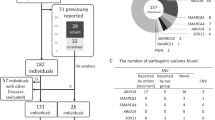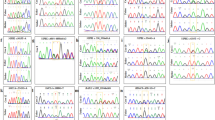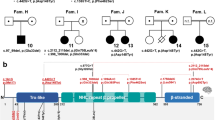Abstract
Schinzel-Giedion syndrome is characterized by severe mental retardation, distinctive facial features and multiple congenital malformations; most affected individuals die before the age of ten. We sequenced the exomes of four affected individuals (cases) and found heterozygous de novo variants in SETBP1 in all four. We also identified SETBP1 mutations in eight additional cases using Sanger sequencing. All mutations clustered to a highly conserved 11-bp exonic region, suggesting a dominant-negative or gain-of-function effect.
This is a preview of subscription content, access via your institution
Access options
Subscribe to this journal
Receive 12 print issues and online access
$209.00 per year
only $17.42 per issue
Buy this article
- Purchase on Springer Link
- Instant access to full article PDF
Prices may be subject to local taxes which are calculated during checkout

Similar content being viewed by others
References
Schinzel, A. & Giedion, A. Am. J. Med. Genet. 1, 361–375 (1978).
Lehman, A.M. et al. Am. J. Med. Genet. A. 146A, 1299–1306 (2008).
Vissers, L.E. et al. Nat. Genet. 36, 955–957 (2004).
Ng, S.B. et al. Nature 461, 272–276 (2009).
Ng, S.B. et al. Nat. Genet. 42, 30–35 (2010).
Hoischen, A. et al. Hum. Mutat. 31, 494–499 (2010).
Tartaglia, M. & Gelb, B.D. Annu. Rev. Genomics Hum. Genet. 6, 45–68 (2005).
Buysse, K. et al. Am. J. Med. Genet. A. 146A, 1330–1334 (2008).
Su, A.I. et al. Proc. Natl. Acad. Sci. USA 101, 6062–6067 (2004).
Varez-Venegas, R. & Avramova, Z. Gene 285, 25–37 (2002).
Krueger, R.C. Jr., Fields, T.A., Hildreth, J. & Schwartz, N.B. J. Biol. Chem. 265, 12075–12087 (1990).
Nieduszynski, I.A. et al. Biochem. J. 271, 243–245 (1990).
Minakuchi, M. et al. Eur. J. Biochem. 268, 1340–1351 (2001).
Panagopoulos, I. et al. Br. J. Haematol. 136, 294–296 (2007).
Minn, D. et al. Am. J. Med. Genet. 109, 211–217 (2002).
Acknowledgements
We thank the subjects and their parents for participation in this study. We thank S. Keijzers-Vloet, J. de Ligt, N. Leijsten and personnel from the Sequencing Facility Nijmegen for technical assistance and I. Saleem for referring patient 3 to us. This study was financially supported by the Netherlands Organization for Health Research and Development (ZonMW grants 917-66-36 and 911-08-025 to J.A.V. and 917-86-319 to B.B.A.d.V.), the EU-funded TECHGENE project (Health-F5-2009-223143 to P.A. and J.A.V.) and the AnEUploidy project (LSHG-CT-2006-37627 to A.Hoischen, B.W.M.v.B., H.G.B., B.B.A.d.V. and J.A.V.).
Author information
Authors and Affiliations
Contributions
A. Hoischen, B.W.M.v.B., C.G., H.G.B., B.B.A.d.V. and J.A.V. conceived the project and planned the experiments. B.W.M.v.B., H.G.B. and B.B.A.d.V. performed review of phenotypes and sample collection. G.M., K.D., M.Z.A., N.R., A.K., M.B., A.T., J.S., C.O., A. Henderson, I.M.H. and E.M.T. clinically characterized the Schinzel-Giedion syndrome cases and collected blood samples. A. Hoischen, P.A. and B.v.L. performed next-generation sequencing experiments. M.S. and P.d.V. performed validation experiments. C.G., R.d.R. and N.W. analyzed and interpreted the data. A. Hoischen, B.W.M.v.B., C.G. and J.A.V. prepared the draft manuscript. All authors contributed to the final manuscript.
Corresponding author
Ethics declarations
Competing interests
The authors declare no competing financial interests.
Supplementary information
Supplementary Text and Figures
Supplementary Tables 1–3, Supplementary Figures 1–3 and Supplementary Note (PDF 917 kb)
Rights and permissions
About this article
Cite this article
Hoischen, A., van Bon, B., Gilissen, C. et al. De novo mutations of SETBP1 cause Schinzel-Giedion syndrome. Nat Genet 42, 483–485 (2010). https://doi.org/10.1038/ng.581
Received:
Accepted:
Published:
Issue Date:
DOI: https://doi.org/10.1038/ng.581
This article is cited by
-
Identification of a novel de novo mutation of SETBP1 and new findings of SETBP1 in tumorgenesis
Orphanet Journal of Rare Diseases (2023)
-
Impaired neurogenesis and neural progenitor fate choice in a human stem cell model of SETBP1 disorder
Molecular Autism (2023)
-
Balanced SET levels favor the correct enhancer repertoire during cell fate acquisition
Nature Communications (2023)
-
PhenoScore quantifies phenotypic variation for rare genetic diseases by combining facial analysis with other clinical features using a machine-learning framework
Nature Genetics (2023)
-
Pirenperone relieves the symptoms of fragile X syndrome in Fmr1 knockout mice
Scientific Reports (2022)



